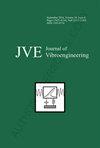不规则建筑结构振动固有频率的估算与控制方法研究
IF 0.7
Q4 ENGINEERING, MECHANICAL
引用次数: 0
摘要
随着不规则建筑数量的不断增加,确保建筑结构的安全已成为人们关注的首要问题。该研究利用有限元分析估算了不规则建筑结构的振动固有频率,并进一步设计了一种与磁流变阻尼器相结合的模糊控制算法,以改善其抗震性能。研究结果表明,模型 1 的纵向和横向固有频率分别为 10.44 Hz 和 10.51 Hz,模型 2 的纵向和横向固有频率分别为 10.31 Hz 和 9.89 Hz。采用模糊控制方法后,建筑结构的峰值位移减小到 11.64 厘米,峰值加速度为 7.9 米/秒2。开环加闭环控制与开环控制方法比较发现,虽然开环控制方法的波动幅度相对较大,但其控制效果较差,而开环加闭环控制方法总体控制效果较好,开环控制的峰值加速度为 8.26 m/s2。该研究为估算不规则建筑结构的固有振动频率提供了一种准确的方法,并证明了所设计的模糊控制算法在控制建筑振动方面的有效性。本文章由计算机程序翻译,如有差异,请以英文原文为准。
Research on estimation and control methods of natural frequency of irregular building structure vibration
With the continuous increase in the number of irregular buildings, ensuring the safety of building structures has become the primary concern. The study used finite element analysis to estimate the natural frequency of vibration of irregular building structures, and further designed a fuzzy control algorithm combined with magnetorheological dampers to improve their seismic performance. The research results showed that the longitudinal and transverse natural frequencies of Model 1 were 10.44 Hz and 10.51 Hz, respectively, while those of Model 2 were 10.31 Hz and 9.89 Hz, respectively. Using the fuzzy control method, the peak displacement of the building structure was reduced to 11.64 cm, and the peak acceleration was 7.9 m/s2. Comparing the open-plus-closed-loop control with open-loop control methods, it was found that although the fluctuation amplitude of the open-loop control method was relatively large, its control effect was poor, while the open-plus-closed-loop control methods had good overall control effect, with the peak acceleration of 8.26 m/s2 in the open-loop control. The study provides an accurate method for estimating the natural vibration frequency of irregular building structures and demonstrates the effectiveness of the designed fuzzy control algorithm in controlling building vibration.
求助全文
通过发布文献求助,成功后即可免费获取论文全文。
去求助
来源期刊

Journal of Vibroengineering
工程技术-工程:机械
CiteScore
1.70
自引率
0.00%
发文量
97
审稿时长
4.5 months
期刊介绍:
Journal of VIBROENGINEERING (JVE) ISSN 1392-8716 is a prestigious peer reviewed International Journal specializing in theoretical and practical aspects of Vibration Engineering. It is indexed in ESCI and other major databases. Published every 1.5 months (8 times yearly), the journal attracts attention from the International Engineering Community.
 求助内容:
求助内容: 应助结果提醒方式:
应助结果提醒方式:


